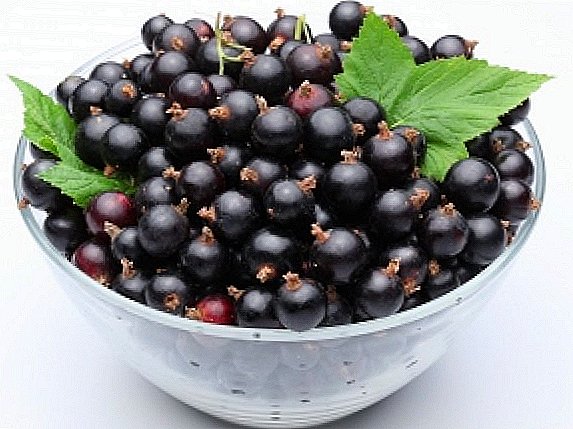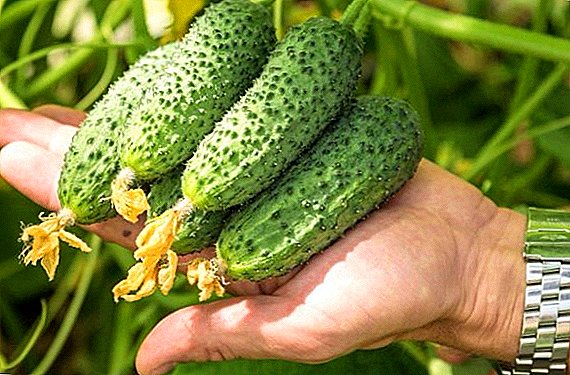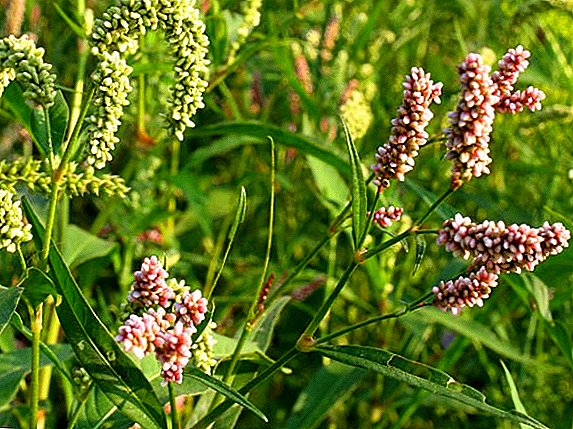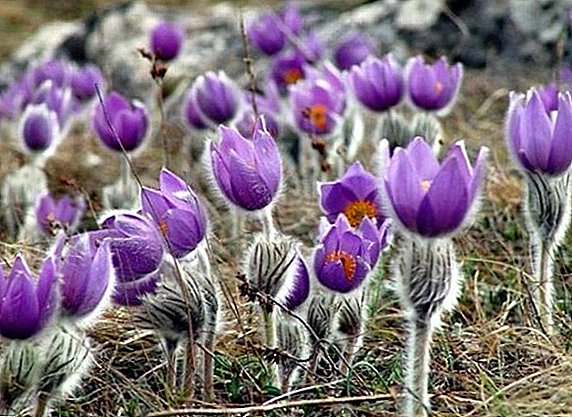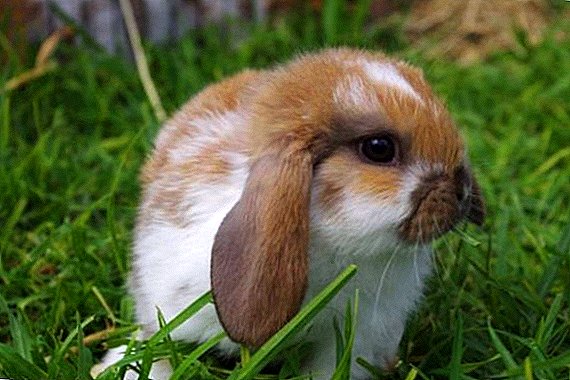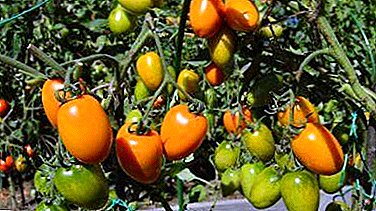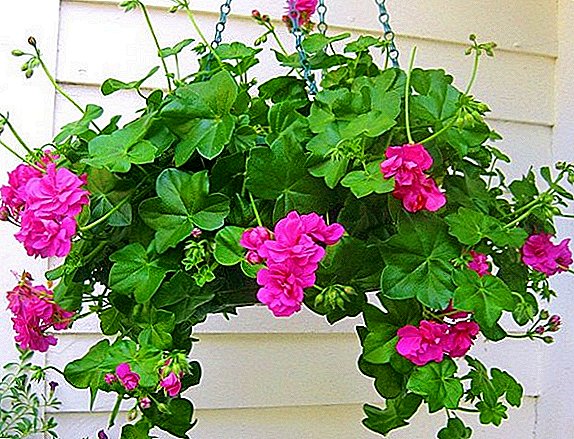 Geranium and pelargonium - one of the most common household plants: they are easy to maintain, bloom very beautifully and also have healing properties - they purify the air of toxins and poisons. How to properly care for pelargonium, what are the optimal conditions for its maintenance, how to protect against pests - consider in more detail.
Geranium and pelargonium - one of the most common household plants: they are easy to maintain, bloom very beautifully and also have healing properties - they purify the air of toxins and poisons. How to properly care for pelargonium, what are the optimal conditions for its maintenance, how to protect against pests - consider in more detail.
Botanical description of the plant
The main feature of this plant from the family of Gerania is hidden in its name - this geranium has oblate leaveswhich resemble ivy in structure: the same five-lobed, leathery and smooth. Under natural conditions, these leaves are very strong, able to wade through stony soil and even rocks, but at home, pelargonium leaves are often thin and have a decorative miniature look.  The branches are long, flexible, hanging down, so this geranium is most often planted in hanging pots and pots. This type of geranium with hanging leaves is called ampel (Ampel - literally means "hanging vase"). Umbrella inflorescences of the type, are formed by 5-9 flowers in one bunch. This geranium usually blooms from mid-spring to mid-summer. The shade of such inflorescences has a rich variety: today there is pelargonium, which blooms in almost all colors.
The branches are long, flexible, hanging down, so this geranium is most often planted in hanging pots and pots. This type of geranium with hanging leaves is called ampel (Ampel - literally means "hanging vase"). Umbrella inflorescences of the type, are formed by 5-9 flowers in one bunch. This geranium usually blooms from mid-spring to mid-summer. The shade of such inflorescences has a rich variety: today there is pelargonium, which blooms in almost all colors. 
Did you know? Geranium is the closest relative of pelargonium: the first specimens of this plant were found in South Africa in the late 17th century, from where they were brought to Europe. Despite the fact that pelargonium and geranium are often referred to as synonymous names, they are two different plants, though from the same family - Geranium.
 The color may be patchy - with contrasting spots, stripes, dots and rims. The size of an adult amber pelargonium can reach 1.5 m in length, so pots with such geraniums are most often placed on a balcony or a cascade stand.
The color may be patchy - with contrasting spots, stripes, dots and rims. The size of an adult amber pelargonium can reach 1.5 m in length, so pots with such geraniums are most often placed on a balcony or a cascade stand.  Under natural conditions, this geranium is formed in small quantities in temperate and warm latitudes, it is found in Italy, Spain, and also in some regions of China.
Under natural conditions, this geranium is formed in small quantities in temperate and warm latitudes, it is found in Italy, Spain, and also in some regions of China.
Ampiel plants are decorative representatives of the flora with hanging shoots and climbing stems that look great in hanging pots and drawers. These are verbena, lobelia, fuchsia, dichondra, petunia.
Growing conditions
The conditions for proper growth and abundant flowering of ivy-like ampel pelargonium are somewhat different from the conditions necessary for ordinary geranium. It requires a special composition of the soil, a certain temperature and lighting.
Did you know? “Pelargonium” literally means “stork” in Greek, and its relative, geranium, means “crane” in translation. Such bird nicknames plants received because of the similarity of their fruits with the beaks of these birds.
Lighting
Pelargonium ampella is one of the few indoor plants that not only needs sufficient lighting, but also absolutely not afraid of direct sunlight. Moreover, a bright light is just what is necessary for the normal functioning of such a flower. It is not recommended to keep Pelargonium near the windows facing the north side - it will grow well and blossom on the south side.
Of course, the plant can live on the north side, however, provided that the daylight will be long, and in the dark (in the winter months) additional artificial lighting will be provided. 
Air temperature and humidity
During the summer months air temperature should not exceed +32 ° COtherwise, in the absence of watering, geraniums may simply burn. In winter, the optimum thermometer should be +15 ° C - it is at this temperature that geranium can bloom even in cold months. Excessively dry air is not terrible pelargonium, it does not need additional moistening and spraying - however, watering should be carried out daily.
Important! Pelargonium leaves are not adapted to excessive moisture - when the fluid accumulates on the leaves, the process of decay may begin. To avoid this, water the flower should be under the roots, avoiding the ingress of water on the leaves.
Optimum soil
The best soil for pelargonium - loose, nutritiousconsisting of a mixture of sand, turf and peat. This texture retains moisture well, but does not contribute to excessive stagnation of water in the roots of the plant. To do this, it is necessary to put a drainage on the bottom of the pot - it will remove excess moisture. The pot itself also needs to be chosen - it is best to use hanging pots or special pots, which are located on the sides of the balcony - it is important to provide enough space for the hanging stems of the plant. 
How to care for pelargonium at home
In order for such an ampel geranium not to hurt, it blooms beautifully and is pleasing to the eye all year round, you need to follow the rules of care, watering and feeding of this light-loving plant.
Learn more about pelargonium: general growing tips, types and varieties - tulip, royal (breeding).
Correct watering
The main rule of watering geraniums - don't overdo it. This flower is very bad tolerates excess moisture, even worse than drought. In the hot summer season, you can water the flower in small quantities every day, however, you need to check the soil - if it has not dried at a depth of 2-3 cm, then watering should be postponed to the next day. Spraying such a geranium is not only unnecessary, but even dangerous - the excess moisture exerts stress on the plant. In winter, it will be enough to water the plant 1 time in 5-7 days (depending on the temperature in the room). 
Plant nutrition
Active feeding requires geraniums in the period of abundant flowering (approximately from May to August). At this time, the plant must be fertilized at least once every 7-10 days with special mineral additives or humus, which are introduced directly into the soil. In the rest of the period, fertilizing is needed less frequently - about once every 20 days. In spring and summer, it is better to apply potash and phosphate fertilizers, and in the fall and winter - humus and other organic matter.
Important! If there is no special fertilizer or potash mineral on hand, you can simply water the geranium with water and milk (2: 1 ratio) - pelargonium loves such milky water, which strengthens its leaves and saturates it with the necessary elements.
Pruning and shaping the bush
In order for pelargonium to be lush and thick, it is cut annually - this procedure is recommended in the first month of spring, immediately after hibernation. Not only all diseased or dried twigs are removed, but all the others - only those shoots that have 2-4 nodes are left. This procedure should be carried out with a sharp knife, it is absolutely impossible to tear off or break off excess leaves - the torn edges of the leaves will begin to rot.
If you nevertheless accidentally tore a leaf, the place of the cliff should be greased with charcoal. The correct pruning of leaves is carried out so that the base of the cutting itself remains on the plant, and not on the torn leaf. Pruning should be carried out on a mandatory basis - only in this way will it be possible to form a shrub of the correct shape, and also to save the plant from weak or diseased shoots.
Video: Ivy Pelargonium Trimming
Transfer
Experienced growers recommend replant ivy geranium no more than 1 time in 2 years. Nevertheless, the young plant needs to be replanted annually, but the old one (4 years or more) - as the roots cover the entire pot (2-3 years). For each replanting, the pot should be slightly larger than the previous one, but the composition of the soil should remain the same.
Did you know? The use of ivy geranium in folk medicine began at the end of the 18th century — it was even called the “flower of the poor”, since the urban poor used the leaves of this plant to purify the air from dampness and toxic intoxication in their homes.
If the original pot is large enough, and you see that the plant is not cramped in it, you can hold partial transplant: remove the top soil, replacing it with fresh one (it is necessary to add dressing). When making a transplant, you need to carefully, grasp the plant by the base and support the roots, move it to a new pot with the prepared moist soil. Try not to damage the leaves, and even more so the roots: the integrity of the integuments of the roots and leaves is the key to a proper and fast planting in a new pot. 
Pest and disease treatment
The main diseases that can occur in pelargonium, are the result of waterlogging and low light. Sometimes it also affects aphid and whitefly - however, the smell of leaves, as a rule, repels aphids, but the whitefly is a fairly frequent inhabitant on the leaves of pelargonium.
Check out tips on how to combat aphids and whitefly.
For the prevention of this pest, geranium is treated with special chemicals or a decoction of dandelion or yarrow. Chemical agents are more effective, but less benign: there is a risk that they will cause a burn on the leaves of pelargonium. The decoction of the dandelion and yarrow contact effect - it acts directly on the pest, without causing damage to the flower itself.  Such folk remedies are applied dotted, in small drops directly on the whitefly - while the plant itself is isolated from the rest of the room flowers until full recovery.
Such folk remedies are applied dotted, in small drops directly on the whitefly - while the plant itself is isolated from the rest of the room flowers until full recovery.
If the leaves wither, turn yellow, rot, a gray patina appears and the base of the stem turns black - this is a clear sign of root rot. In this case, an emergency transplant of a plant into a new, clean pot with fertilizer is necessary, at the bottom of which a drainage is placed.
Find out why geranium leaves turn yellow, how to treat a plant.
How to propagate Pelargonium ileum
At home, there are 2 ways to breed such geraniums: cuttings and seeds.
Growing from seed
This method is less common - it is pretty troublesome and time consumingtherefore, geraniums are more often propagated by cuttings. When sown with seeds, geranium sometimes loses its varietal characteristics. For such reproduction, you need to prepare the right soil: it should be a mixture of peat, sand and sod in equal proportions. The pot itself should be low.  In order for the seeds to sprout quickly, it is necessary to provide them with a constant temperature of + 22-24 ° С, therefore, it is better to carry out this procedure in the summer months. The seeds of the plant are placed in a moist soil, covered with a film and placed under a permanent source of light. After 8-12 days, the first shoots will appear - now the film needs to be removed, and the sprouts themselves must be carefully moistened (it is better to bring water under the roots from the medical syringe). As the first shoots get stronger (after 3-4 weeks), they are transplanted into small pots up to 10 cm in diameter. If you follow all the rules, the first flowering of young Pelargonium grown in this way can happen only a year later.
In order for the seeds to sprout quickly, it is necessary to provide them with a constant temperature of + 22-24 ° С, therefore, it is better to carry out this procedure in the summer months. The seeds of the plant are placed in a moist soil, covered with a film and placed under a permanent source of light. After 8-12 days, the first shoots will appear - now the film needs to be removed, and the sprouts themselves must be carefully moistened (it is better to bring water under the roots from the medical syringe). As the first shoots get stronger (after 3-4 weeks), they are transplanted into small pots up to 10 cm in diameter. If you follow all the rules, the first flowering of young Pelargonium grown in this way can happen only a year later.
Video: Cultivation of Ivy Pelargonium from seeds
Read also about the cultivation and types of geraniums: gorgeous, blood-red.
Cuttings
Cutting is the most convenient method of breeding pelargonium. First of all, you need to prepare the correct cuttings - they must be apical, cut off at the end of winter or at the end of summer: this is the optimal time for grafting.
The cutting itself must contain at least 3-4 leaves. A freshly cut stalk is dried in the open air for about a day, and the next day, before direct planting, the place of the cut is treated with a special agent - a root formation stimulator. Sometimes it is simply smeared with charcoal. Then the substrate is prepared - a mixture of peat, sand and turf.  Cuttings are planted in the prepared soil around the perimeter of the pot - it is important to leave a sufficient distance between the seedlings (at least 12 cm). A container with cuttings is placed under diffused light - the soil is sprayed regularly. After 2-3 weeks, the seedlings will take root and strengthen. After 30-35 days after planting, seedlings can already be transplanted into individual pots (they should not be large in size).
Cuttings are planted in the prepared soil around the perimeter of the pot - it is important to leave a sufficient distance between the seedlings (at least 12 cm). A container with cuttings is placed under diffused light - the soil is sprayed regularly. After 2-3 weeks, the seedlings will take root and strengthen. After 30-35 days after planting, seedlings can already be transplanted into individual pots (they should not be large in size).
Remember: the larger the pot, the worse pelargonium will bloom. As a result of propagation by cuttings, young seedlings of pelargonium can bloom after only 6-8 months.
Video: Ivy Pelargonium growing by cuttings
Reviews of flower growers on the cultivation of Ivy Pelargonium



Ileum Pelargonium is a very bright and beautiful plant that during the flowering period will adequately decorate not only the window sill, but also the local area and the winter garden. Knowledge of the rules of maintenance and care of this evergreen shrub will allow you to create a beautiful blooming cascade that will please the eye all year round.


